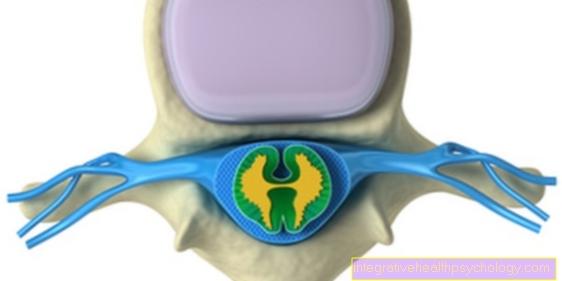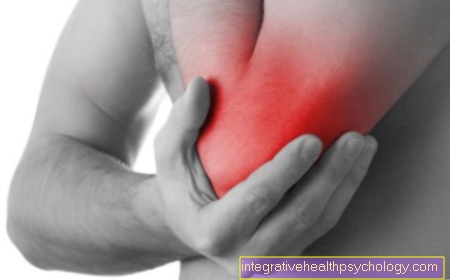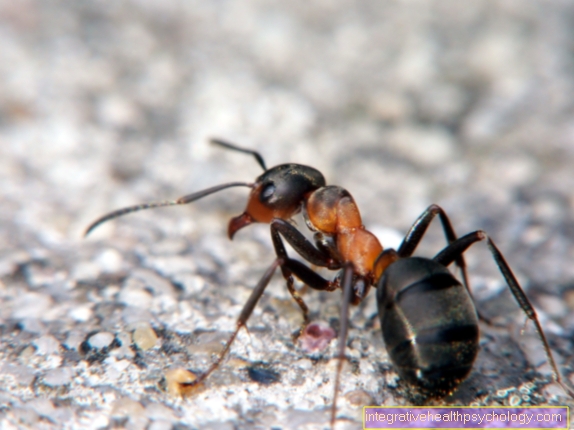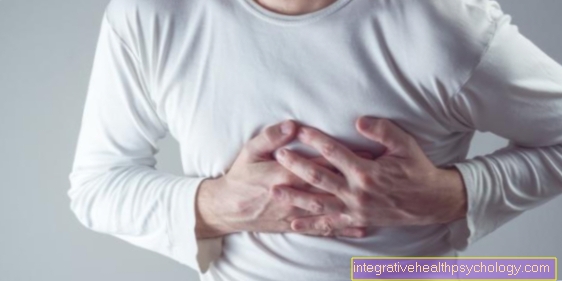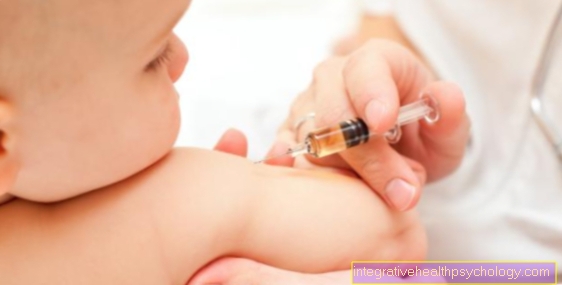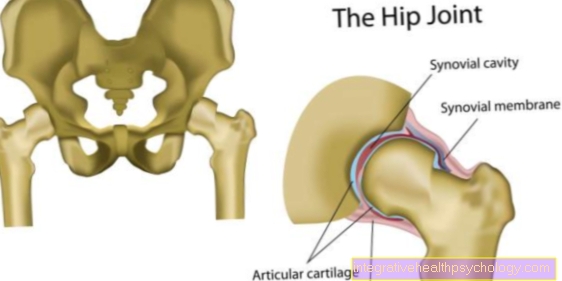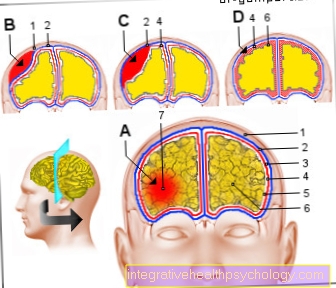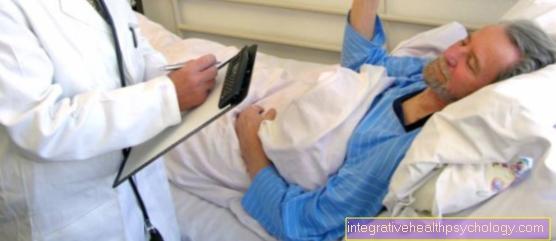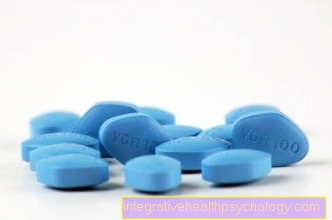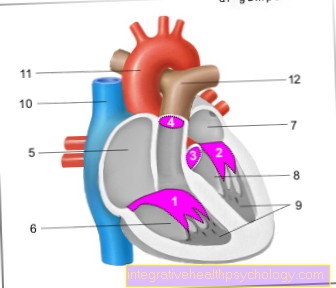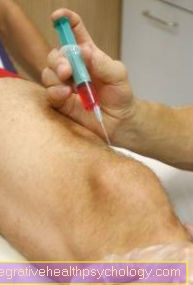Varicose veins on the testicles - It's that dangerous!
synonym
Varicose vein on the testicle = varicocele
What is a varicose vein on the testicle?
In the case of a varicose vein, the venous plexus on the testicle is visibly and palpably enlarged and can be described as a tangle of vessels. In technical terms, a varicose vein on the testicle is also referred to as a varicocele. As with varicose veins on the legs, the function of the veins in the return transport of blood is impaired, with the left testicle being particularly affected. For example, due to non-functioning venous valves or a weak tissue. Varicoceles are common. Young men are often affected.
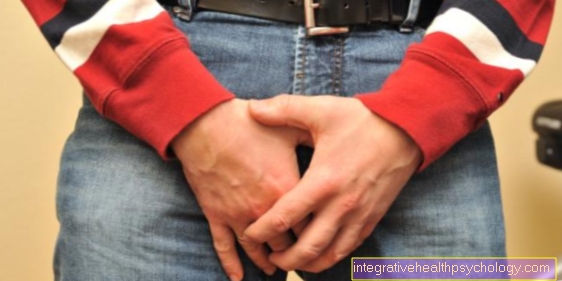
Causes of a varicose vein on the testicle
A primary (idiopathic) varicocele is differentiated from a secondary (symptomatic) varicocele based on the cause. The primary varicocele is genetic and accounts for most cases. It is caused by a disturbed blood backflow, causing the blood to accumulate in the testicular veins. This phenomenon occurs particularly on the left side, as the testicular veins open into the renal vein at an unfavorable angle. This has a negative effect on the venous return flow. The right testicular vein opens directly into the inferior vena cava. Furthermore, a weakness of the venous valves in the testes or a weak vascular wall can promote the formation of varicoceles. But there are other factors that can negatively affect blood flow. In the case of a secondary varicocele, the external pressure applied to the right or left testicular veins leads to less blood backflow. This can be in the context of tumor formation, for example. On the other hand, a thrombosis, i.e. a blood clot, or a tear in the testicular vein can lead to a varicocele.
Symptoms of a varicose vein on the testicle
In most cases, a varicocele has no symptoms. But sometimes typical symptoms can also occur. These symptoms include a feeling of a heavy, filled, bulging scrotum. This feeling is felt more strongly when standing. The disturbed blood flow leads to swelling and an increase in size of the affected testicle. In addition, the varices form worm-like on the scrotum. The varicose veins appear more clearly with increased abdominal pressure. In children, the affected testicles can be smaller, as the varicocele inhibits growth. In addition, sperm production can be impaired in the further course. Another possible complication of a varicocele is decreased testicular volume.
There can of course be other causes than a varicocele behind a swollen testicle. For more information, we recommend our website to: Testicle is enlarged and swollen
Pain in the testicle
Varicose veins on the testicles are not necessarily associated with pain. At the beginning, pain is rather untypical. As the testicle grows in size, pain can arise. In addition, an uncomfortable feeling of heaviness or tension is possible. Pain in the testicles should always be clarified by a doctor.
However, if you suffer from pain in the testicles, we recommend our website for further clarification: Testicular Pain - What's Behind It?
Swelling of the testicle
The disturbed blood flow leads to an accumulation of blood in the affected testicle. This leads to an increase in size and swelling of the testicle. This can be perceived as uncomfortable. However, since testicular swelling occurs in many diseases, a doctor should be consulted as soon as possible to clarify the cause.
For more information you should take a look at our page: Testicle is enlarged and swollen
Treatment of varicose veins on the testicles
There are no drugs against the varicose veins on the testicles. The varicose veins can usually be treated with a small operation, as long as it is a primary varicocele. Therapy does not have to be given in every case. Factors that speak for an intervention are pain, reduced testicular volume, a severe varicocele or if the varicocele is perceived as uncomfortable. There are several options here. The goal of any alternative is to occlude the vein. The blood can drain through other veins. One possibility is sclerotherapy. A substance is injected into the vein, which causes it to become obliterated. For this purpose e.g. A catheter is pushed into the testicular veins through a vein in the groin. The remedy can be given through this. However, this method is unsuccessful in some cases. Embolization is similar to sclerotherapy. Only here a tissue glue or a spiral is put into the vessel to close it. In the case of a secondary varicocele, e.g. caused by an external pressure, the cause must be eliminated, for example a tumor must be removed.
Further information on this topic can be found at: Remove varicose veins
Can I treat the varicose veins on the testicles myself?
Often no surgery is necessary to treat a varicocele because it does not cause any symptoms. An intervention does not guarantee an improvement of the problem. However, a few general measures can also improve a varicocele by avoiding factors that negatively affect the testicles. Bad posture, muscle imbalances in the pelvic floor muscles and in the back, and a weakened cardiovascular system are said to have negative effects. Smoking and excessive alcohol consumption also have a negative effect. Another point to consider is the ideal testicular temperature, which is important for sperm production. The wrong clothing can easily make the testicle temperature too high. The right underwear is important for the right temperature. It should be supportive and breathable, but not too tight. It is also advisable to wear pants made of thin material. Jeans are often made of thick fabric and collect heat. Furthermore, heavily padded seats are unfavorable. When sitting for a long time, it is advisable to get up in between or to spread your legs slightly. Bad posture can also cause testicular temperature to increase slightly. In addition, good posture can improve blood circulation.
Sclerotherapy for a varicose vein on the testicle
Sclerotherapy is a method by which vessels are obliterated with the help of an agent that is given into the affected veins. However, the success rates are worse than with the other options, e.g. an operative procedure.
For more information on the sclerosing of varicose veins, see: Remove varicose veins
Surgery for a varicose vein on the testicle
During the operation of a varicocele, the affected veins are tied off and cut. If necessary, they are also cut out completely. This procedure can be done either through a larger incision or through several very small holes, i.e. laparoscopically. The surgical instruments are inserted through these small incisions. The operation usually does not take long, usually less than an hour, and there are relatively few complications. The operation can be carried out on an outpatient or inpatient basis.
How long are you on sick leave after surgery for a varicocele?
How long you are on sick leave depends on whether the operation went well and which procedure it was. As a rule, one to two weeks can be expected. If the job is physically demanding, it can also be a longer period of time. If any complications, such as inflammation, arise from the procedure, you will of course be on sick leave for longer.
Dangers of varicose veins on the testicles
Can the varicose vein burst?
There is no need to worry about the varicose vein bursting. There is no such risk.
Does this limit my fertility or can it lead to infertility?
The exact relationship between varicoceles and infertility has not been sufficiently clarified. However, it is believed that the varicocele impaired sperm production. The temperature in the testicles rises due to the reduced blood return through the vein.The normal testicle has a temperature which is 2 degrees below the average body temperature, this is optimal for the development of the sperm. When the temperature in the testicle is elevated, sperm production is impaired. It is not clear to what extent possible changes in pressure due to poor blood circulation affect sperm production. A varicocele can also be detected in around a third of infertile men. If infertility is suspected, advanced diagnostics can be performed. As part of this, the hormones and sperm can be examined for their function. If there is a varicocele and an unfulfilled desire to have children, surgery can be considered. But there are also many men with a varicose vein on their testicles who are still fertile.
For more information on this topic, we recommend our page on: Infertility in men
Can the varicocele make me impotent?
To what extent a varicocele actually leads to the inability to conceive is unclear. It is only noticeable that some men with a varicocele have reduced sperm production. At the same time, however, many men are able to reproduce despite a varicocele. The varicocele itself has no influence on the ability to erect.
Read more on this topic under: Male infertility
Prognosis with a varicose vein on the testicle
Apart from possible infertility, there are no serious consequences to fear from the varicocele itself. To maintain fertility, however, it is important to see a doctor. Symptom-free varicoceles do not require any therapy and do not lead to any consequences. In many cases, an already existing infertility cannot be reversed by surgery. However, with good therapy, freedom from pain can be achieved and the testicular volume increases again. It is also assumed that the sperm function will improve again.
We also recommend our site to: Infertility in men
Diagnosis of a varicose vein on the testicle
First there is a conversation with the doctor. This is followed by the physical examination. First, the doctor examines the testicle while standing. Because the veins stand out best through gravity. If necessary, the patient is asked to increase the pressure in the abdomen by pressing. This makes the varicoceles appear even better. The patient then lies down. With a primary varicocele, there is now a significant improvement in the varicose veins. If the veins do not recede, a secondary varicocele is probably the cause. The physical examination is followed by an ultrasound scan to visualize and assess the vessels. The abdomen can also be examined for any obstructions to drainage.



